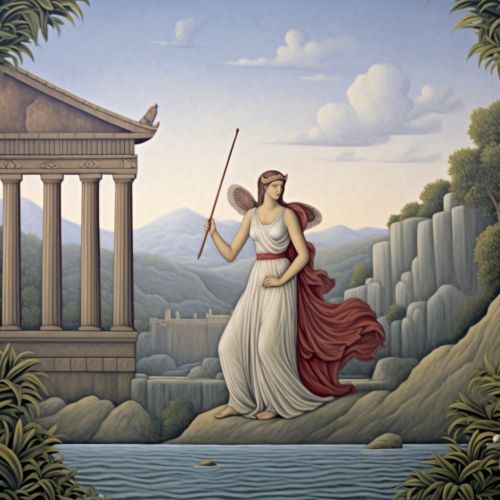Rhea (mythology)
Origins
In Greek mythology, Rhea is a Titaness, the daughter of the sky god Uranus and the earth goddess Gaia. She is the sister and wife of the Titan Cronus, and mother to many of the most well-known gods and goddesses in the Greek pantheon, including Zeus, Hera, Poseidon, Hades, Hestia, and Demeter.


Role and Characteristics
Rhea's primary role in Greek mythology is as the mother of the gods. She is often referred to as 'the mother of gods' due to her role in giving birth to several of the Olympian gods and goddesses. Her name, which means 'flow' or 'ease', is reflective of her nurturing and motherly characteristics. As a Titaness, Rhea is associated with the natural world and its cycles, particularly the flow of time and generations.
Mythology
Rhea's most famous myth involves the birth of her children. Her husband Cronus, having overthrown his father Uranus, feared that he would be overthrown by his own offspring. To prevent this, he swallowed each of his children as they were born. However, when Rhea was pregnant with her youngest child, Zeus, she sought help from Gaia and Uranus. They advised her to give Cronus a stone wrapped in swaddling clothes, which he swallowed, thinking it was his son. Rhea then hid Zeus in a cave on the island of Crete, where he was raised and eventually fulfilled the prophecy by overthrowing Cronus.
Worship and Cult
Rhea was worshipped throughout the ancient Greek world, but her cult was particularly strong in Crete. She was often depicted in art and sculpture as a matronly woman, sometimes riding a lion or seated on a throne. Her festivals, known as the Rheaia, were celebrated with games and sacrifices.
Legacy
Rhea's legacy extends beyond the realm of mythology. The second-largest moon of the planet Saturn is named after her, as is the genus of large, flightless birds known as rheas. Her story has been retold and reinterpreted in numerous works of literature and art throughout history.
